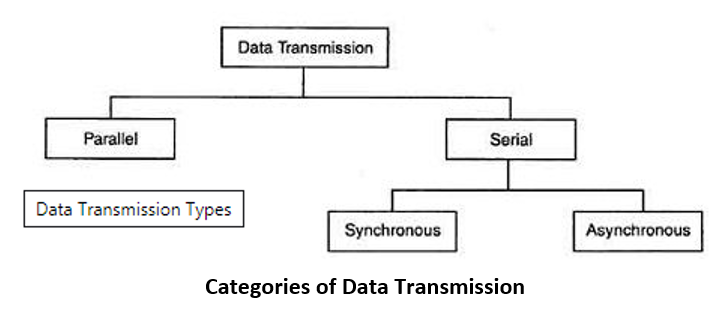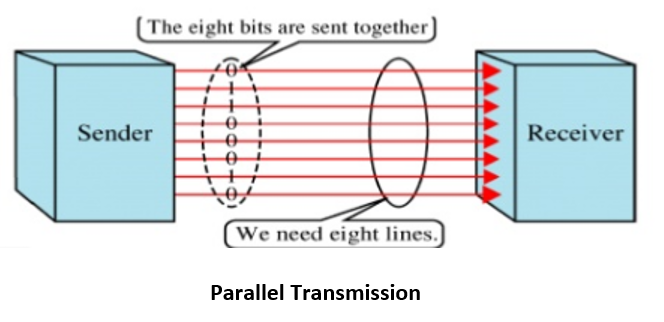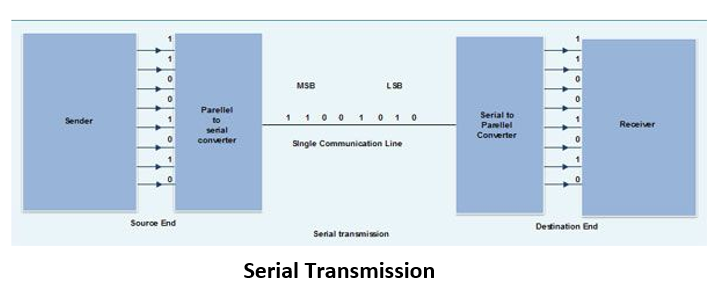Home »
Computer Network
Data Transmission: What It Is, Types, Advantages, and Disadvantage
Computer Network | Data Transmission: In this tutorial, we will learn about the data transmission, its types, advantages, and disadvantages.
By Monika Jha Last updated : May 05, 2023
What is Data Transmission?
When considering the transmission of data from one device to another is the wiring, and of primary concern when considering the wiring is the data stream.
- It is the movement of data in the form of bits between two or more digital devices.
- We can transmit either analog or digital signals from the sender to the receiver. So, data transmission is also referred to as digital transmission or digital communications.
- Transfer of data is done via some form of transmission media such as coaxial cable, optical fiber, etc.
- Data transmission may be external or internal. External that is one device to another whereas internal means communication takes place between different parts of the same device.
- For example, data goes from the random access memory (RAM) or hard disk to a processor is a form of data transmission.
Types of Data Communication
The following are the two types of data transmission:
- Parallel Data Transmission
- Serial Data Transmission

1. Parallel Data Transmission
Binary data includes 0s and 1s, maybe organized into groups of n bits. Computers produce and consume data in groups of bits much as we conceive of and use spoken language in the form of words rather than letters. We can send data n-bits at a time instead of one using grouping. This is called parallel transmission.
- The mechanism for parallel transmission is a conceptually simple one: use n wires to n bits at one time. In this way, each bit has its wire, and all n bits of one group can be transmitted with each clock pulse from one device to another.
- The bits of a byte that is 8 bits are transmitted simultaneously on separate wires. If two devices are close together computer or printer so the communication within the computer.
This figure shows how parallel transmission works for n=8. With a connector at each end, eight wires are bundled in a cable.

When Parallel Data Transmission Is Used?
Parallel transmission is used when,
- A large amount of data is to be sent over communication lines.
- When the data is time-sensitive.
- The requirement of sending data quickly to the receiver.
For Example: During video streaming the time when a video is streamed to a viewer, bits need to be sent quickly to prevent a video pausing or buffering.
If we want to send large volumes of data then that data is also time-sensitive. If there are slow data streams, it will result in poor viewer experience.
Advantages of Using Parallel Data Transmission
- It is easier to program.
- Data is sent much faster as parallel transmission can increase the transfer speed by a factor of n over the serial transmission.
Disadvantages of Using Parallel Data Transmission
- Transmission of n communication lines is required to transmit the data stream and for this n number of wires must be required.
- This is expensive so it is usually limited to shorter distances.
- If there is an increase in the number of users these wires will be too many to handle.
2. Serial Data Transmission
In serial transmission, one bit follows another that is in this transmission one bit flows at one clock pulse, so we need only one communication line rather than n to transmit the data between two communicating devices.
- When serial data transmission is used to send or receive data, the data bits are organized in a particular order, since they can only be sent one after another.
- The order of the data bits is important as it determines the organization of the transmission when it is received.
- It is supposed as a reliable and efficient data transmission method because, after the reception of the previous data bit, the next data bit is sent.
- The serial transmission also occurs in two ways: Synchronous and Asynchronous Transmission.

When Serial Transmission Is Used?
Serial Transmission is used when,
- It is generally used for medium to long-distance data transfer.
- In USBs (Universal Serial Bus).
- It transfers the data bits in a specific order, one after another. In this way, data bits are received in-sync with one another so it maintains the data integrity.
- Transmission to other devices that is external data transfer.
Advantages of Using Serial Transmission
- With only one communication channel serial transmission reduces the cost of transmission with a factor of n.
Disadvantages of Using Serial Transmission
- Slow Speed of data transfer.
- Increasing clock frequency is required to increase the speed of data transfer.
Advertisement
Advertisement